In this guide we set out which core CV sections you must always include and which optional CV sections you might want to include, if you have space and if they are relevant to the role. We explain the purpose of each section and provide example content.
TIP: If you’re a little unsure which sections to include or how to write a particular section of your CV, our CV templates will help!
Personal information / contact details
Your personal information must be included on your CV and usually goes at the top.
Name
Write your first and last name as you’d expect people to call you in a professional setting. It’s fine to shortened version of your first name such as Jon or Jen rather than Jonathan or Jennifer, if that’s what you usually use. However, you should never use an unprofessional nickname.
Professional title
If you have a professional job title or letters after your name, include this. It helps employers quickly identify that you meet their criteria, and may assist if they are using an Applicant Tracking System (ATS).
For example, if you are an associate member of ICAEW, you should include the letters ‘ACA’ after your name and you may want to add the professional title ‘ICAEW Chartered Accountant’ underneath your name.
Click here for our accountant CV templates.
Address
Include your full postal address.
Phone
Provide at least one phone number that the prospective employer can use to contact you. This might be a mobile or landline, for example – but don’t give your landline if you’re unlikely to be at home to take the call.
Provide an email address that is reasonably professional (such as your name). Examples: jenlwiss@gmail.com or johnlsimmons@hotmail.co.uk.
If, like many people, you have added your year of birth to your name (e.g. jenlwiss1977@gmail.com), this could invite age discrimination. You may wish to set up another free email address with Gmail for the purpose of your job applications. You can forward any mail to your usual personal address, so you don’t have to keep checking your new inbox. Here’s how to forward your new gmail address to another account.
Social accounts
You can add social accounts with your personal details, if appropriate. You might want to include your LinkedIn and Twitter handles, and possibly a link to your YouTube channel.
Your LinkedIn account can be used to add further detail about your previous roles, skills and achievements. It can also be used to showcase endorsements and recommendations which can act as extremely powerful testimonials. Only include your LinkedIn handle if you’ve set your profile up properly. Find out more about setting up your profile here. Include your handle on your CV like this:
LinkedIn: @jenwiss
Did you know? Having a completed LinkedIn profile can increase your interview chances by 71%!
Actively using Twitter to engage with other industry professionals can help create a positive impression with prospective employers.
“Share links that are relevant to your followers, adding commentary to the latest industry news. This shows that you’re keeping up with industry trends and gives potential employers a look into what you read and care about, which will help them to envision how you may fit into their company’s work environment.”
~ Mashable
YouTube
If you have a YouTube channel that’s professional, include the handle. Your channel does not necessarily need to be relevant to your industry – creating a popular channel with professional content can help demonstrate a very wide range of skills to prospective employers. If your channel is off-topic, just make sure that you explain on your CV why you’ve included the link (i.e. which transferable skills it demonstrates).
Blog
Include your blog handle provided that the content is professional and suitable for the employer. The blog does not have to be industry relevant – it could instead be used to demonstrate strong written communication and marketing skills. If it is off-topic, make sure you explain on your CV why you’ve included the link (i.e. which transferable skills it demonstrates).
Specific requirements
Sometimes employers request specific requirements such as a ‘full clean driving licence’ or a ‘Driver Certificate of Professional Competence’ (CPC) for lorry, bus or coach drivers. To ensure that recruiters quickly identify you as a qualifying candidate, it is advisable to include this information at the top with your personal details.
What to leave out
Always leave these details off your CV, unless absolutely essential and relevant to the role:
- Race
- Religion or belief
- Marital or civil partnership status
- Age
- Disabilities
- Gender
- Sexual orientation
These are protected characteristics and if one applies to you, prospective employers should not discriminate against you because of it. However, it does still happen so this type of information is best left off.
“The problem of racism in the UK is one that remains worrisome. Religious discrimination, particularly Islamophobia, is once again on the rise in the UK and following the Brexit referendum, the UK saw a sharp increase in the number of xenophobic attacks carried out.” ~
Example CV personal details section
Here is an example of how your personal details might typically be presented on your CV template:
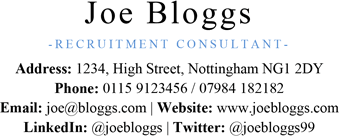
Above: Recruitment consultant CV template
Profile CV section
The profile section of your CV is optional, but is typically included. It might be called something else – for example, ‘Personal Statement’, ‘About me’ or ‘CV summary’. Whatever you call this section, its purpose is to introduce yourself and tell the prospective employer clearly and succinctly how you fit the job role. For example:

Typically this section of your CV will be 3 or 4 sentences. However, for some job roles, it will need to be more extensive. An example of this would be where the role requires a lot of specific skills and experience. In this case, a bulleted list confirming that the requirements are met works well:
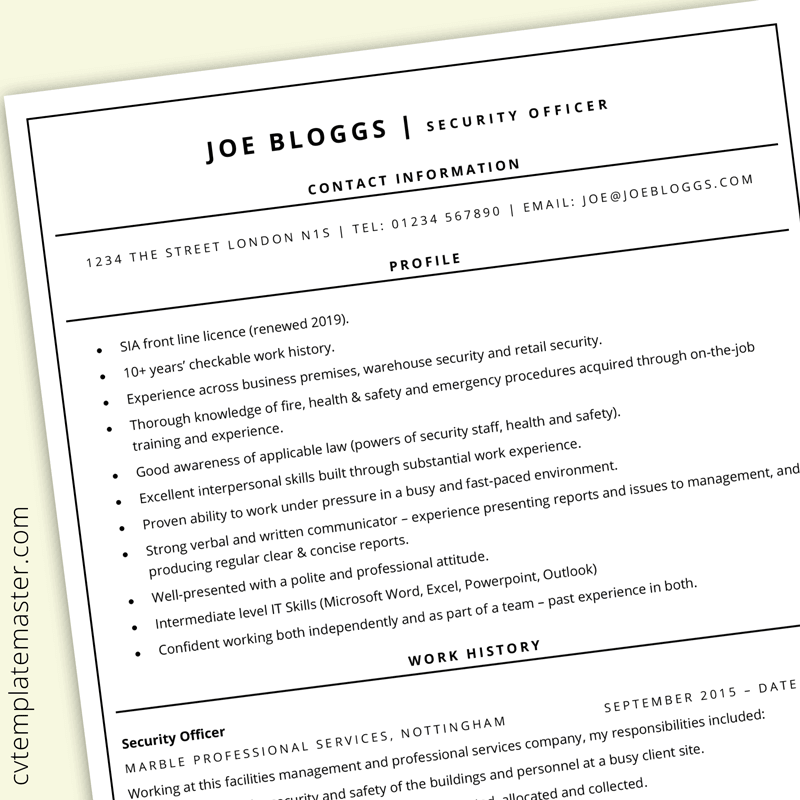
Above: This Security Guard CV template uses a lengthier ‘profile’ section to demonstrate key skills and experience.
Experience / work history CV section
This section will set out where you have worked and the responsibilities you had in each role. It is usually presented in reverse chronological order (most recent role first).
Where possible, it should not simply be a list of responsibilities and nothing else. Having those responsibilities is not proof that you did a great job! Instead, try to point out what you achieved in the role. Use this list of action verbs from MIT to inspire you when writing about your achievements.
For example:
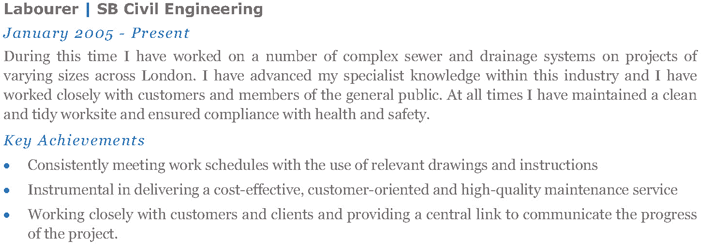
Above: Labourer CV template
Example achievements:
- Re-organized something to make it work better
- Identified a problem and solved it
- Come up with a new idea that improved things
- Developed or implemented new procedures or systems
- Worked on special projects
- Received awards
- Been complimented by your supervisor or co-workers
- Increased revenue or sales for the company
- Saved money for the company
- Saved time for the company
- Contributed to good customer service
Source: International Hellenic University
Example achievement statements:
- Developed a new employee orientation program that 100% of the company locations adopted.
- Responded to over 85 customer calls daily and solved 90% of their concerns.
- Served customers in a positive way, receiving two customer service awards in the past year.
- Assisted credit manager in account collection by phone and mail, increasing accounts receivables by 20%.
- Created a multi-media campaign that increased enrolment by 700 students in eight years.
Source: IHU as above.
Education / qualifications / training
In this CV section, you’ll set out what education and training you have completed and (if relevant) which qualifications you attained.
How far back you go depends on your highest qualification.
- If you have an undergraduate degree, it’s typical to list your A Levels + degree.
- If you don’t have an undergraduate degree, it’s typical to list GCSEs / A Levels as applicable.
For each item you include, give the subject, year of study, grade attained and place of study.
You can also list relevant training courses and vocational qualifications completed in this section. For example:
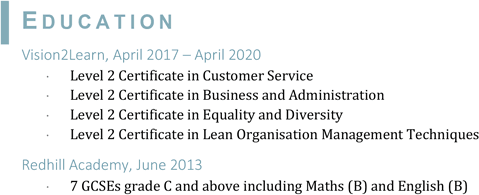
Above: Store Manager CV template
Skills
The skills section of a CV is optional. In most cases you should be able to include your skills within the personal profile, work history and education sections. However, for some jobs (such as computer programming), you may wish to include a separate skills section. You can also optionally indicate your level of skill (e.g. beginner, intermediate, advanced or an industry-specific level).
Including a separate skills section may be helpful if the employer is using ATS software. They will have programmed the software to scan for particular keywords and the skills section can ensure you cover all of those directly.
It’s fine to list off hard skills such as knowledge of a particular programming language. For example:
- PHP – intermediate (6+ years)
However, it’s not okay to list off soft skills in the same way, without offering any evidence. Anyone can claim to have a soft skill such as ‘teamwork’ – and putting this into a list adds no value to your CV. Instead, try to offer evidence for having the skill. Here are some examples from our Summer Job CV template (there are lots more examples on this CV):
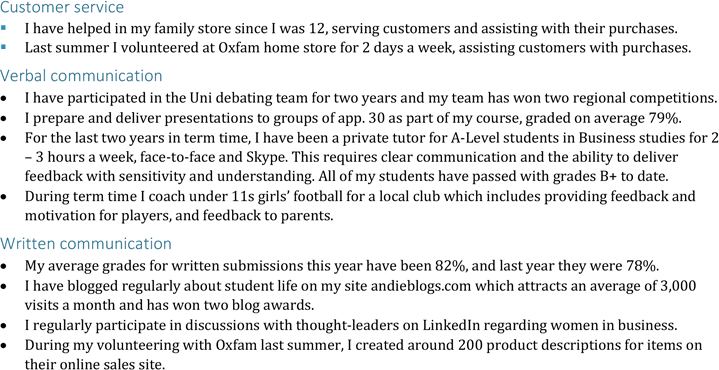
Above: Summer Job CV template
Memberships
If you are a member of any industry-relevant professional organisations, you may wish to add a memberships section. This section is optional but membership of a professional body can help demonstrate to prospective employers that you have a passion for the industry and an interest in its development.
For example, as a lawyer you might be a member of:
- The Law Society
- The Sole Practitioners’ Group (SPG)
- CILEx
If you are actively involved with any of the bodies, you could mention this. If you have a membership registration, you may wish to note this.
Publications
If you have authored or co-authored any industry-relevant publications, you can include these on your CV. Alternatively, you might choose to add them to your LinkedIn profile and signpost the employer to these in your CV.
Example:
“I have authored/co-authored 12 journal articles on aspects of Private Client Law, details of which can be found on my LinkedIn profile @jenwiss.”
Awards and achievements
If you have received awards for your work, you may wish to include these in a section on your CV. These are powerful, providing third party endorsement for your skills. Alternatively, you could provide details on LinkedIn and signpost the employer to your LinkedIn profile.
Example:
“I have received 5 awards from CILEx and the Law Society since qualifying, details of which can be found on my LinkedIn profile @jenwiss.”
CV interests section
It’s optional to include interests on your CV but this section can be valuable for demonstrating soft skills.
For example:
“I have further honed my teamwork, communication and leadership skills playing for the Arnold Wanderers since 2010 and coaching the Arnold Under 16s football clubs since 2015.”
Hobbies and interests can also help an employer to see how you’ll fit into their organisation and culture. Find out more about writing the hobbies and interests section of your CV here.
References
The references section is optional. An employer will ask for references anyway if they decide to offer you a job.
You may wish to include references if they are particularly impressive and add value to your CV. Find out more in our article ‘How to write references in a CV‘.
In addition, a comment or two from someone with knowledge of your work who is willing to endorse your skills can be a powerful addition here. This might be an extract from a LinkedIn recommendation. For example:

Above: Connect Quotes CV template
Order of CV sections
The order of sections on your CV depends on the country you’re applying to and the type of CV you’re submitting. Generally in the UK, the following sections are expected in this order:
- Personal / contact information
- Personal statement / profile
- Education / qualifications
- Work history / experience
- Hobbies and interests
- References
However, if you decide to use a skills section, this may be inserted either after the personal profile or after the work history, depending on how important you deem it to be. See our skills based CV template for example.
